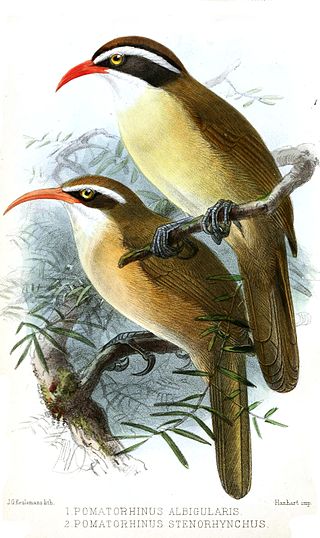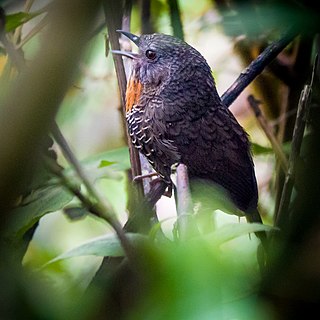
The wrentit is a small bird that lives in chaparral, oak woodlands, and bushland on the western coast of North America. It is the only species in the genus Chamaea.

The pin-striped tit-babbler, also known as the yellow-breasted babbler, is a species of bird in the Old World babbler family Timaliidae that is found in South and Southeast Asia.

The Indian grassbird is a passerine bird in the family Pellorneidae. It was formerly placed in the Old World warbler family, Sylviidae, and the Old World babbler family, Timaliidae.

The grey-cheeked tit-babbler is a species of bird in the family Timaliidae. It is endemic to Java.

The fluffy-backed tit-babbler is a species of bird in the family Timaliidae. It is found in Brunei, Indonesia, Malaysia, and Thailand. Its natural habitats are subtropical or tropical moist lowland forest and subtropical or tropical swampland. It is threatened by habitat loss.

The brown tit-babbler is a species of bird in the family Timaliidae. It is endemic to the Philippines. Its natural habitats are subtropical or tropical moist lowland forest and subtropical or tropical moist montane forest.

The Javan scimitar babbler is a species of bird in the family Timaliidae. It is endemic to Java, Indonesia. The Sunda scimitar babbler, which is found in Sumatra, Borneo, and Malaysia, was formerly considered conspecific, with both species being grouped as the chestnut-backed scimitar babbler. Its natural habitats are subtropical or tropical moist lowland forest and subtropical or tropical moist montane forest.

The red-billed scimitar babbler is a species of bird in the family Timaliidae. It is found in Northeast India, Southeast Asia and adjacent parts of southern China.

The streak-breasted scimitar babbler is a species of bird in the family Timaliidae.

The pied shrike-babbler is a bird species traditionally considered an aberrant Old World babbler and placed in the family Timaliidae. But as it seems, it belongs to an Asian offshoot of the American vireos and may well belong in the Vireonidae. Indeed, since long it was noted that their habits resemble those of vireos, but this was believed to be the result of convergent evolution.

The black-headed shrike-babbler is a bird species traditionally placed with the Old World babblers in the family Timaliidae. However, it might be one of the few Eurasian vireos (Vireonidae).
The spotted thrush-babbler also known as the thrush babbler, is a species of bird in the family Pellorneidae. It is found in Angola, Cameroon, Central African Republic, Democratic Republic of the Congo, South Sudan, and Zambia. Its natural habitats are subtropical or tropical moist lowland forest and subtropical or tropical moist shrubland.

The Mishmi wren-babbler is a species of bird in the family Timaliidae. It is endemic to Northeast India.

The rusty-crowned babbler is a species of bird in the family Zosteropidae. It is native to the southern Philippines.
The sooty babbler is a species of bird in the family Timaliidae. It is found in Laos and Vietnam. Its natural habitat is subtropical or tropical moist lowland forest. It is threatened by habitat loss.

The Cachar wedge-billed babbler or chevron-breasted babbler is a species of bird in the Old World babbler family (Timaliidae). It is named for the Cachar Hills in southern Assam.

The grey-sided scimitar babbler is a species of bird in the family Timaliidae. It is found in southern China. Its natural habitats are subtropical or tropical moist lowland forest and subtropical or tropical moist montane forest.

The Taiwan scimitar babbler is a bird in the family Timaliidae, the Old World babblers. It is endemic to Taiwan. The species was first described by Robert Swinhoe in 1859. It was formerly treated as a subspecies of the streak-breasted scimitar babbler. Its population is declining, but not rapidly enough for it to be considered vulnerable.

The bold-striped tit-babbler is a species of Old World babbler found in Southeast Asia.
The Kangean tit-babbler is a species of bird in the family Timaliidae. It is endemic to the Kangean Islands.

















